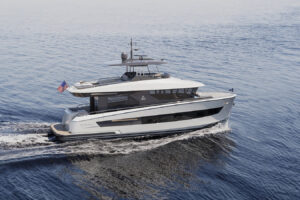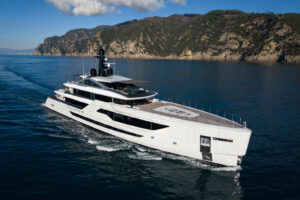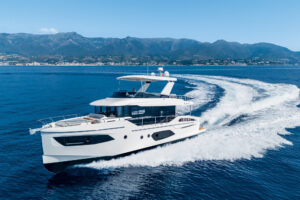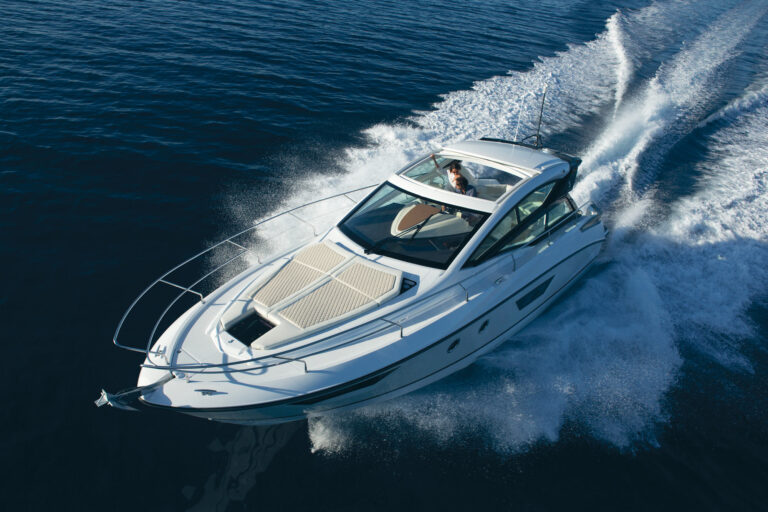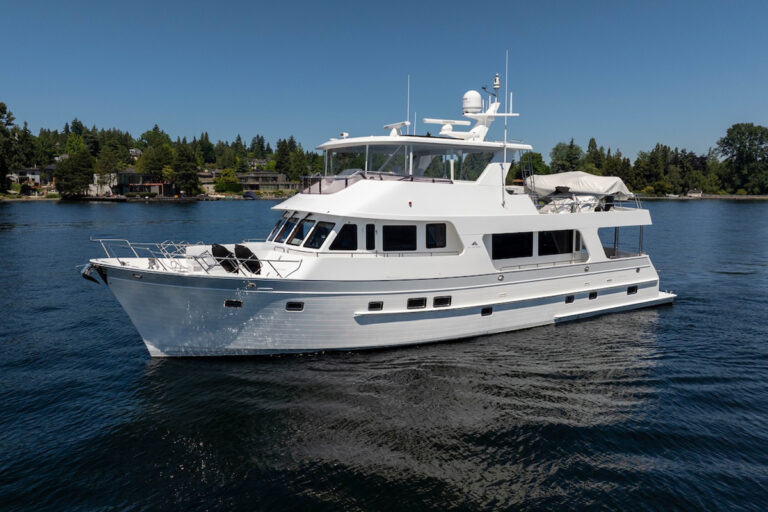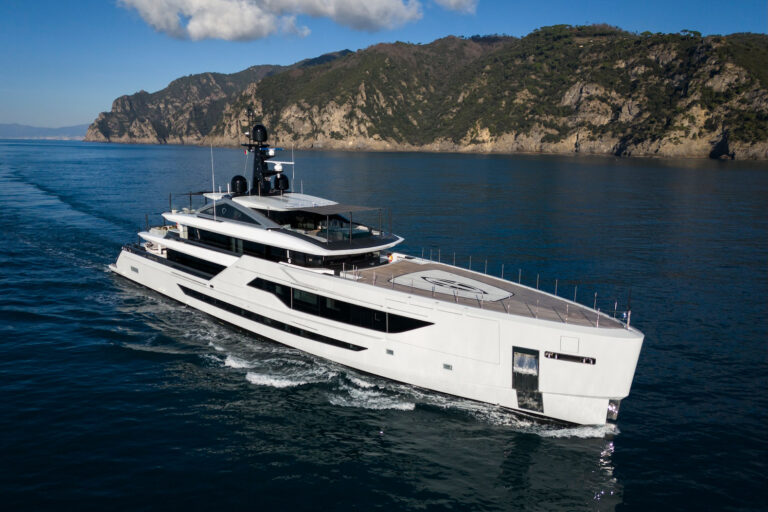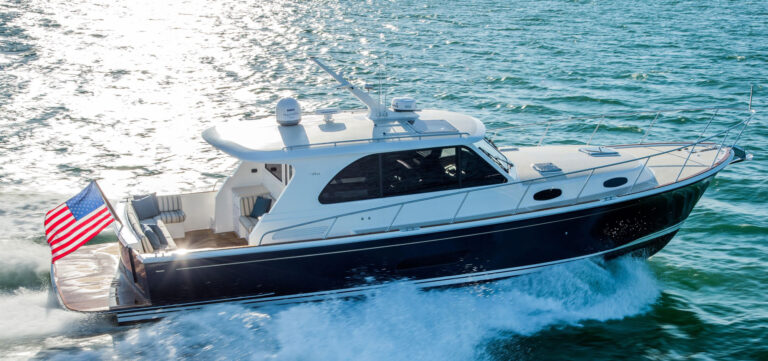There is a widely held belief that a true sportfishing war wagon must have the mystical ability to “raise fish”. Not only should record-size fish be attracted to the waters around the boat, but something-perhaps the hull’s resonance-should put them in the mood to be caught.
Several builders have built their reputations on that indefinable quality, and Mikelson has worked in recent years to add its name to that list. The Mikelson 61 CMT Pilothouse Yachtfisher, designed to carry owners to distant fishing grounds in comfort, continues that effort.
Early boats from the Southern California-based builder reflected the fishing styles of the Pacific, with casting platforms on the bow and bait tanks in the foredeck. With easily driven hulls by Tom Fexas and the long legs needed to fish the Mexican canyons, Mikelson soon became the hot ticket for serious Western fishermen.
Company principals Pat Sullivan and Dick Peterson soon realized there were owners who needed more than just a sportfisherman. Some wanted to move up into more of a motoryacht, some needed to stay out of the sun, and some wanted to range farther afield. The 61, which Sullivan called a “unique beast, is a response to those needs.
Owners wanting more of an all-weather motoryacht will appreciate the ability to air condition and heat the 61’s pilothouse. Serious anglers will look to her large, fully outfitted cockpit and flying bridge with after helm controls.
Liquidity, the sixth of the 61s, had a crew that couldn’t resist dragging a few lines on her maiden voyage from San Diego through the canal to Florida. The result was a 400-pound marlin off Guatemala and, one crew member said, “too many sailfish to count. They even took one sail from the flying bridge on light tackle.
Liquidity is the first California Marine Technologies version of the 61. CMT is a company founded by the owner of this particular yacht. For want of a better description, the 61 CMT is the Eddie Bauer Package of the Mikelson line: carefully and thoughtfully upgraded with an array of systems and gear that creates an integrated package. Rather than leaving the choices to an owner, who may wind up with mismatched “glue-on options, the CMT version is an assemblage of the best products that work together. From the sophisticated freshwater system to the cockpit hardware to the Naiad stabilizers to the silent Tecma heads, this is literally a turnkey yacht for discriminating buyers who want to delegate the time-consuming details to specialists.
Unlike many so-called “yachtfishers” that simply tack on a water-level cockpit to a motoryacht, the 61 CMT has a cockpit that is first and foremost a fighting cockpit. Oversize bait wells are built into the transom, a big Scopinich fighting chair is amidships, and Rupp outriggers are overhead. A pair of sizable fishboxes underscore the intention to take record fish, and one has an Igloo ice chipper to chill the take. To port is a day head that opens into the cockpit, and two large hatches lead to the lazarette and full access to the steering system.
Three steps above the cockpit, the saloon has a wraparound leather sofa to starboard facing a low counter with what appears to be a pop-up TV. But no, what pops up from the cabinet is a full-size line spooler, a reminder that this is a serious sportfisherman. The television, as part of the CMT package, is a Sony 36-inch flat screen that swings down electrically from the overhead.
The pilothouse is designed to be the living area while under way, with the galley open to the saloon and helm. The space includes a U-shape settee with table to port and a stylish Recaro Maritime helm seat in black leather that slides on rails recessed in the teak-and-holly sole. The instrument panel includes flat-screen displays, Twin Disc Power Commander shifters and full electronics from the commercial-grade Furuno radar to the scanning sonar.
One notable helm feature, which is typical of the Mikelson approach, is what appears to be a locker behind the settee. It is actually a hatch that leads behind the helm, allowing service personnel full access to the electronics and the AC and DC wire terminations.
The galley has stainless-steel GE Monogram appliances, including an Advantium Speedcook oven. All countertops are fitted with stainless sea rails. A Flavia commercial coffee system is a nice touch. The cook should have a superb view forward, as well as to each side.
Forward and below, the master stateroom spans the full beam under the pilothouse. An L-shape desk and vanity are to starboard, while a fawn leather chair and dresser are on the other side of the king island berth. The master head is stylish, with a glass sink atop the vanity and instant hot water through the tall arched faucet. The oversize shower has a seat, and the Tecma head is part of a sophisticated waste system that includes electronic monitoring of the holding tank.
The foyer conceals a washer/dryer, and there is a small locker for stowing detergent. Crew quarters with bunk beds are to port.
Forward is the VIP, with a raised berth and a shared head with shower. Under the VIP berth is access to the bow thruster and stowage that Liquidity utilizes for a pair of freezers.
The flying bridge cleverly combines a forward helm, an entertainment area and an aft sportfishing helm. A pair of Stidd chairs is behind the curved instrument panel with a built-in chart area, while an L-shape settee is for guests. A nice touch is the hidden chart locker that swings down from the hardtop with space for full-size charts to be stowed flat.
A wet bar with barbecue and refrigerator is to starboard, and the port side on Liquidity holds the liferaft, although a tender and crane could just as easily be installed.
A fiberglass helm console and leaning post provide a perch for the skipper to keep an eye on the fishing action in the cockpit, with Palm Beach-style throttle/shifters on each side of the pod. Above the bridge hardtop, Liquidity also has a two-person tuna tower with full controls, twin electronics domes and its own hardtop.
The engineroom is reached in a civilized manner through a watertight door under the cockpit steps. Hands-on owners will appreciate the generously sized compartment with full access to all sides of the 800 hp Caterpillar 3406E mains. With the standard 1,850 gallons of fuel, these engines give Liquidity a range of around 1,200 miles at 10 knots and a top speed of 26.5 knots.
If proof were needed regarding the Mikelson 61’s offshore ability, Liquidity is a good example. Immediately after launching in California, she cruised on her own bottom down the Pacific coast to Panama in just eight days, despite a gale off Papagayo. The 4,000-mile voyage to the Miami International Boat Show is impressive, but more so in a 67-footer (she’s 61 feet on the waterline).
Under way, she has the soft and predictable motion necessary for a long-range sportfisherman, and the delivery crew assured me Liquidity backs down hard and with authority.
Mikelsons have always been known for having systems that are easy to service and access, and the 61 is a fine example of that premise. Solidly built, comfortably long-legged and designed to be as much a motoryacht as a sportfisherman, she should attract attention on both coasts.
Contact: Mikelson Yachts, (619) 222-5007; fax (619) 223-1194; www.mikelsonyachts.com.

